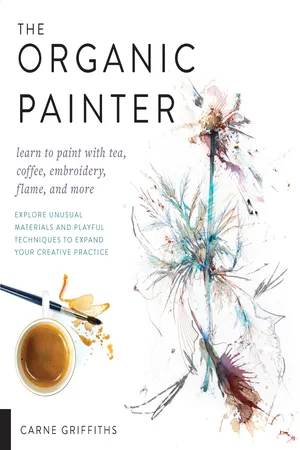
The Organic Painter
Learn to paint with tea, coffee, embroidery, flame, and more; Explore Unusual Materials and Playful Techniques to Expand your Creative Practice
- 128 pages
- English
- ePUB (mobile friendly)
- Available on iOS & Android
The Organic Painter
Learn to paint with tea, coffee, embroidery, flame, and more; Explore Unusual Materials and Playful Techniques to Expand your Creative Practice
About this book
Bored with the same old paints? The Organic Painter introduces innovative techniques for using non-traditional "paint" derived from materials like coffee, tea, and alcohol, to encouragefreedom and expression! Traditional art supplies will only take you so far! Sometimes you need to try something completely new and different. That's where The Organic Painter comes in. With a little guidance, you'll soon be painting with everyday materials you'd never considered as an artistic medium. This inspiring book gives you all the techniques and ideas you'll need to boost your creativity, learn natural paint-making, andbe more resourceful with your art materials. Imagine the unique things you'll make when you create natural paints from coffee, tea, embroidery and flame. Each project in this guide bookcomes with instructions on how to make the paint, and alsoincludes experiments and explorations for you to try. Plus, asimple painting accompanies every featured material and combines it withother materials ortechniques, so you'll never lack inspiration.
Frequently asked questions
- Essential is ideal for learners and professionals who enjoy exploring a wide range of subjects. Access the Essential Library with 800,000+ trusted titles and best-sellers across business, personal growth, and the humanities. Includes unlimited reading time and Standard Read Aloud voice.
- Complete: Perfect for advanced learners and researchers needing full, unrestricted access. Unlock 1.4M+ books across hundreds of subjects, including academic and specialized titles. The Complete Plan also includes advanced features like Premium Read Aloud and Research Assistant.
Please note we cannot support devices running on iOS 13 and Android 7 or earlier. Learn more about using the app.
Information
Part 1:
PREPARING YOUR MATERIALS

PREPARING SURFACES: STRETCHING PAPER AND PRIMING OBJECTS
GETTING STARTED

THE PROCESS
Preparing the Surface


Drying
Applying Watercolor Primers
Table of contents
- Cover
- Title Page
- Contents
- Introduction
- Part 1: Preparing Your Materials
- Part 2: Projects
- Samples of Work
- About the Author
- Index
- Dedication
- Copyright